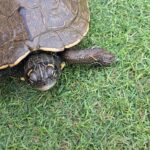Six line wrasse care (Pseudocheilinus hexataenia)
Looking for a fish that’s colorful, easy to keep, reef safe, inexpensive and can be kept in relatively small tanks? There’s a reason the six line wrasse is one of the most popular saltwater aquarium fish. A perfect choice for beginning reef keepers, this active little fish never disappoints.
Keep reading for everything you need to know about six line wrasse care!
| Name (Common, Scientific) | Six line wrasse, Pseudocheilinus hexataenia |
| Minimum tank size | 30 gallons |
| Minimum group size | 1 |
| Temperature | 72-78 °F |
| Salinity | 1.022-1.025 |
| pH | 8.1-8.4 |
| Difficulty level | Easy |
Six line wrasse (Pseudocheilinus hexataenia) description
Definitely the most striking aspect of the six line wrasse is its color. The species does indeed have six horizontal orange stripes running across its blue body. It sports a green tail fin with an eyespot, orange face and two bright white horizontal lines across the orange-red eyes.
The six line wrasse is one of the smaller wrasses at a maximum size of around 4”.

Six line wrasse (Pseudocheilinus hexataenia) aquarium
Because six line wrasses don’t grow as large as many other wrasse species you won’t need a large aquarium to keep them; around 30 gallons is a good place to start.
Six line wrasses naturally occur in reef environments, so it’s very important to provide plenty of hiding spots, caves and live rock that can be patrolled and scoured for food.
Six line wrasse (Pseudocheilinus hexataenia) compatibility
So, earlier we described the six line wrasse as pretty much the perfect aquarium fish. Unfortunately there’s almost always a catch and for this species it’s compatibility.
The good news: six line wrasses are reef safe and won’t bother your corals.
The bad news: they can be big bullies that might outcompete slower species for food and can occasionally end up killing their tankmates through their relentless harassment. Aggression towards other wrasse species is particularly intense, so it’s not a good idea to keep multiple varieties together unless you can offer lots of space.
As for other tankmates, the way to go here is make sure that the six line wrasse is the last species introduced into the aquarium. This way it won’t have an established territory and will generally behave much better. If it’s not the last species and you introduce another fish, the wrasse will often bother it for at least a few days or even longer, which is very stressful.
Invertebrates make up part of a six lined wrasse’s natural diet. Although six lines coexist just fine with crabs and shrimp, others will hunt them or might suddenly start doing so at a later age. Caution is advised here. Sessile invertebrates like anemones and feather dusters seem to be left alone.

Six line wrasse (Pseudocheilinus hexataenia) diet
This species is a typical reef dweller that pretty much consumes anything it can find that fits into its mouth.
You should always provide some live rock for your six line wrasse to use as foraging grounds; you’ll see it spend most of its day darting around, picking off any benthic invertebrates it can find. Pyramidellid snails, an annoying parasitic pest, are considered a tasty snack. The same goes for commensal flatworms, which often hitchhike into the aquarium and are innocent but pretty unsightly. Your six line wrasse will make quick work of them!
Even with a good amount of live rock, do make sure you supplement the diet of your six lined wrasse. Frozen foods like mysis and brine shrimp are big favorites but you can also offer regular flake and pellet foods.
Conclusion
Hardy fish like the six line wrasse are suitable choices for beginning aquarists, but maintaining a saltwater aquarium still requires specialist knowledge.
Don’t have time to become an aquarium guru? Let FantaSEA Aquariums handle the design, set-up and maintenance of your tank so all you have to do is enjoy it.



